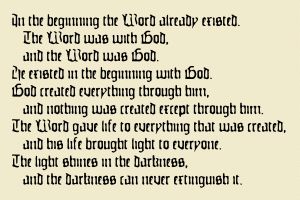Lectio divina is a way to read scripture and other sacred writing contemplatively. It’s different from bible study or a reading plan — the goal is not to read thoroughly but deeply; to experience the text with an open heart; to comprehend the Truth beneath the words. Comprehend means to hold completely, to know interiorly, to unite with. The purpose of lectio divina is to bypass the literal information-collecting way we normally read and unite with some deeper Truth in the text that touches us personally. Lectio does not replace bible study and other rational ways of encountering scripture; it offers an entirely different perspective, grounded in contemplative principles.
Lectio divina has become much more popular in recent years, and it’s a traditional practice during Advent. So every year around this time, I’m asked by friends and colleagues for guidance or recommendations on the subject, and every year I point people to the wonderful chapter on lectio in my former spiritual teacher Cynthia Bourgeault’s book The Wisdom Jesus: Transforming Heart and Mind, as well as this page on the Contemplative Outreach site and this one on the ignatianspirituality.com site of Jesuit publisher Loyola Press. But every year, also, I think I should write something myself. My reluctance comes from the feeling that I am only a beginner, and that I should leave the writing to those who know more. But lectio, like meditation or any contemplative practice, is something which, though you do it your entire life, is always fresh, always changing. There are dry spells and overflowing ones. There are sudden breakthroughs into deeper practice, and periods where you can’t seem to go deep at all. And there is the remarkable phenomenon with lectio of remeeting the same text over and over and finding it to be different, not because it’s changed but because you have.
So we’re all beginners in the sense that lectio is structured to have us encounter the text with what Buddhists call “a beginner’s mind.” And an inspiring conversation with a friend the other day helped me realize that sharing my learning with you, rather than my expertise, may be just as useful if not more so. So with all that prefacing, here then is an introduction to lectio divina.
Perhaps you’ve heard lectio divina mentioned by a spiritual teacher or friend on the contemplative journey. If you are a Catholic, you might know that Pope Benedict was a huge fan of lectio (while at the same time inexplicably being hostile towards the centering prayer practice which largely sprang from it). And many centering prayer groups explore lectio regularly or as a special event. My church, St. Lydia’s, approaches the scripture readings every week in a style modeled after the first stage of lectio.
Lectio divina, like many other contemplative practices, can be done alone or with a group with the practice being essentially the same in both cases, but the effect somewhat different. While the details vary somewhat in different traditions, there are two essential principles. The first is that the reading be done slowly, without theatrics yet without being passionless, and that the reading be done aloud if at all possible even if you are practicing alone. A related note: the passage should be brief enough to take in as a whole, probably no more than a paragraph, and as little as a sentence. Second is the structure of the practice. There are four stages: lectio (reading); meditatio (reflecting); oratio (praying); contemplatio (contemplating). Traditionally one moves through the stages in order, though some modern writers suggest a looser more flowing structure.
Here, in snapshot bullet-point list form, are the stages of lectio divina and the essential aspects of each. As I said, there is plenty of variation on the details within the framework, but this is my method and as good a place to start as any.
lectio (reading)
- Collect yourself with 1 minute of silence.
- Read the passage once slowly aloud, noting what sentence, phrase or single word strikes you in the text — the important thing is not what strikes you or why, but that it does.
- Sit in silence for 1 minute or more.
- Read the passage again slowly.
- If in a group, share the sentence, phrase or word you were drawn to (even if someone else has already said it.)
meditatio (reflecting)
- Read the passage again.
- Quietly and calmly let yourself — your reason, imagination, memories and emotions — think about the passage, especially the part to which you were drawn. It might bring up memories and thoughts and send you off into a whole scene in your imagination; or it might agitate you, make you feel angry or confused or overwhelmed in a non-specific way. If so, think about what it’s triggering and why. Or conversely you might be drawn positively to a phrase or image in the text, comforted or flooded with joy; again, think about why.
- If no feelings are coming easily, or if you prefer this method: Play with putting yourself in the scene, imagining the key piece of text being said near you or by you, with you live in the presence of the action. (This is the Ignatian practice of visualizing oneself in Bible scenes.)
oratio (praying)
- Rooted in the phrase that you were drawn to and the reflections you just experienced, turn to dialogue with God.
- You may pray for help or comfort involving things that came up; or express thanksgiving or worshipful feelings. Sometimes my vocal prayer is simply, “Thank you. Thank you.” Just take a few minutes relating to God in whatever way you normally do with prayer, but centered around the phrase or image or idea that struck you in the text.
- This stage is a little tricky in group settings. You might instruct folks to pray silently, or quietly, or you might encourage participants to voice the prayers out loud one at a time. Bourgeault recommends sending folks away to do these final stages in private.
contemplatio (contemplating)
- Resting in God.
- Just sit with God after the prayer period for 3 minutes or more of silence, without attaching to thoughts. You are not thinking about the passage, or what came up in meditatio and oratio, but neither are you ignoring it all. It is now part of the reality in which you are sitting with God. Your prayers of words in oratio may drift naturally into contemplatio; if so, just let it happen.
- This phase is essentially centering prayer, and, as mentioned, was a big part of the inspiration for the development of that practice.
While lectio divina is typically done with bible passages, it can be used for any sacred writing. And why not with “secular” poetry? (I say “secular” in quotes because all poetry is sacred in a sense.)
This is nothing but a snapshot. I haven’t even touched on the history of lectio, which stretches back to the very beginnings of Christianity, to Origen, Ambrose and the Desert Fathers and Mothers. There are books worth that could be said; on the other hand, as with other contemplative practices, that is all just information, while there is no substitute for doing, for being. So, give it a try. I would love to hear how you are using lectio, in your personal contemplative life or as part of a community. I look forward to writing more about it in the future, inspired by your comments. Happy Advent!
















